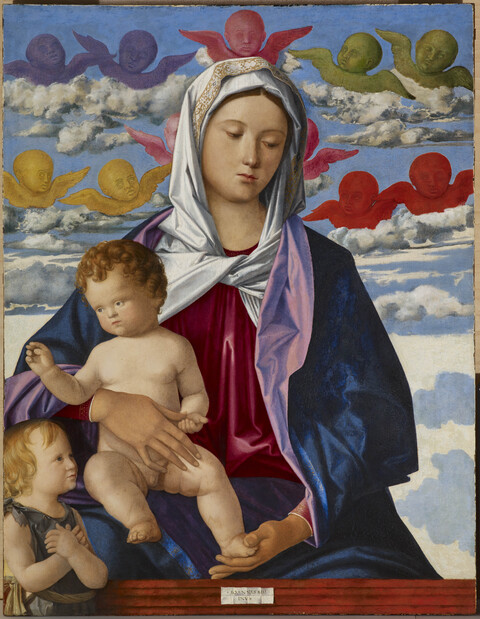Marks, Inscriptions, and Distinguishing Features
Inscribed on parapet cartellino: IOANNES BELL/INUS
Entry
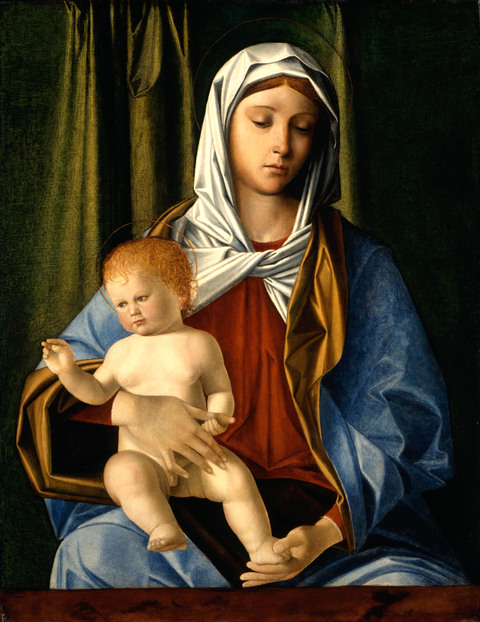
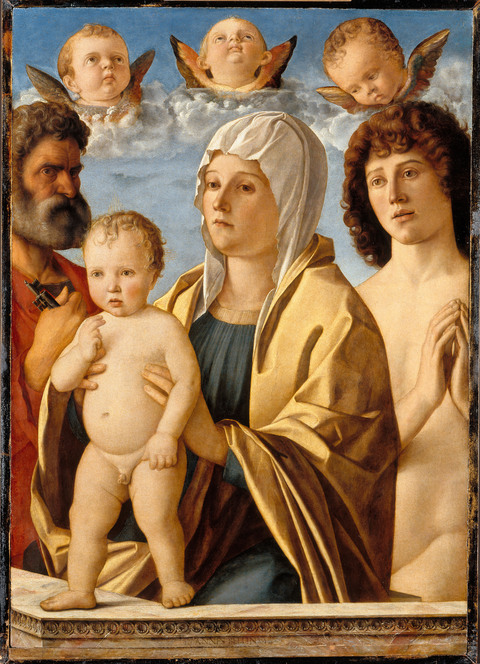
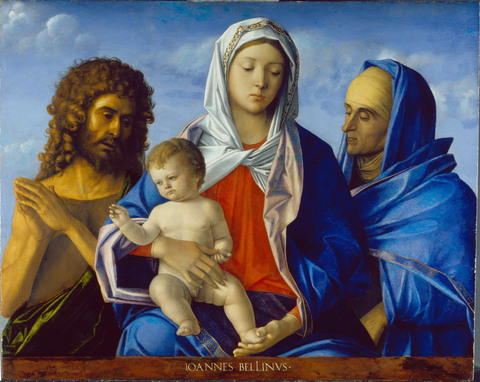
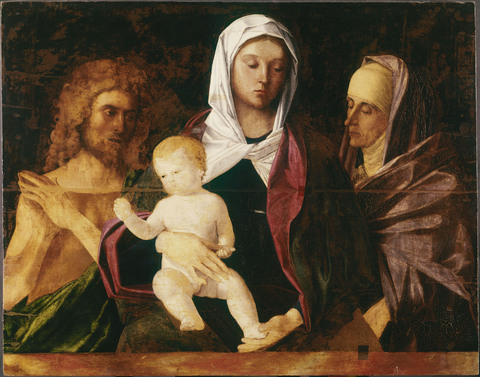

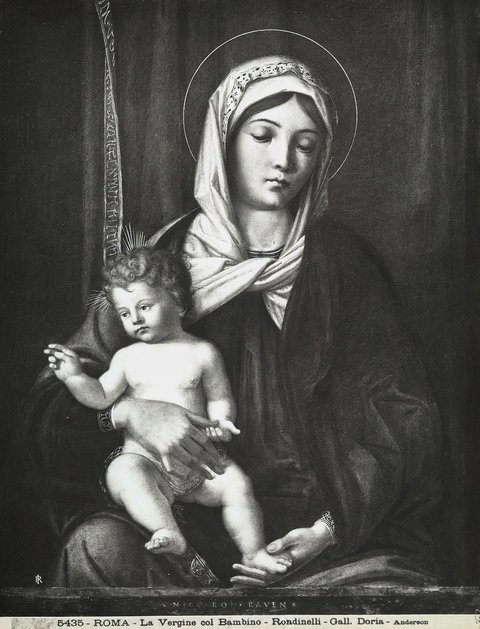
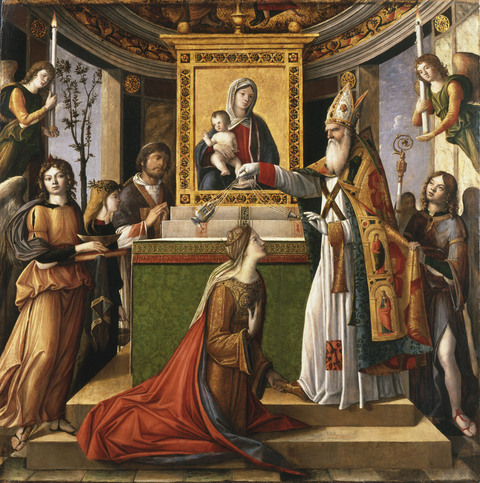
Author
Provenance
Possibly Baron Thienen-Adlerflycht, Salzburg.35
Possibly (Otto Schatzker, Vienna, and for a time, Berlin) about 1932.36
Possibly Berlin art market, about 1932.
(E. and A. Silberman, New York) before 1935;
Dr. George Henry Alexander Clowes, Indianapolis, in 1935;37
The Clowes Fund, Indianapolis, from 1958–2000, and on long-term loan to the Indianapolis Museum of Art since 1971 (C10004);
Given to the Indianapolis Museum of Art, now the Indianapolis Museum of Art at Newfields, in 2000.
Exhibitions
Dallas Museum of Fine Arts, 1936, Exhibition of Painting, Sculpture, and Graphic Arts, no. 9;
John Herron Art Museum, Indianapolis, 1959, Paintings from the Collection of George Henry Alexander Clowes: A Memorial Exhibition, no. 4;
The Art Gallery, University of Notre Dame, Notre Dame, IN, 1962, A Lenten Exhibition, no. 5;
Indiana University Art Museum, Bloomington, 1962, Italian and Spanish Paintings from the Clowes Collection, no. 18;
Indianapolis Museum of Art, 2004–2005, Giovanni Bellini and the Art of Devotion.
References
Wilhelm Suida, “Una Madonna di Giovanni Bellini,” Rivista di Venezia 13 (August 1935): 353–354 (reproduced);
Bernard Berenson, Italian Pictures of the Renaissance: Venetian Schools, 2 vols. (London: Phaidon, 1957), 1:37;
Paintings from the Collection of George Henry Alexander Clowes: A Memorial Exhibition, exh. cat. (Indianapolis: John Herron Art Museum, 1959), no. 4 (reproduced);
Fritz Heinemann, Giovanni Bellini e i Belliniani, 3 vols. (Venice and Hildesheim, 1962–1991), 1:30, no. 118 (g); 2:240, fig. 241 (reproduced); 3:14, no. 118g;
Mark Roskill, “Clowes Collection Catalogue” (unpublished typed manuscript, IMA Clowes Archive, Indianapolis Museum of Art, Indianapolis, IN, 1968);
A. Ian Fraser, A Catalogue of the Clowes Collection (Indianapolis: Indianapolis Museum of Art, 1973), 12–13 (reproduced);
Ronda Kasl, ed., Giovanni Bellini and the Art of Devotion (Indianapolis: Indianapolis Museum of Art, 2004), 91–159 (reproduced);
Antonietta Gallone and Cinzia Mancuso, “Observations sur l’emploi de la couleur mauve dans l’atelier de Giovanni Bellini,” in Hélène Verougstraete, ed., La peinture ancienne et ses procédés / Copies, répliques, pastiches; colloque XV, Bruges (11–13 septembre 2003) (Peeters: Leuven, 2006), 79–83 (reproduced).
Notes
-
The most comprehensive attempt to identify and sort the compositional designs of Giovanni Bellini and the replicas that followed is credited to Fritz Heinemann, Bellini e i Belliniani, 3 vols. (Venice and Hildesheim, 1962–1991). More recent considerations of this task include Andrea Golden, “Creating and Re-creating: The Practice of Replication in the Workshop of Giovanni Bellini,” in Giovanni Bellini and the Art of Devotion, ed. Ronda Kasl (Indianapolis: Indianapolis Museum of Art, 2004), 91–127. Anchise Tempestini, “Bellini and His Collaborators,” in The Cambridge Companion to Giovanni Bellini, ed. Peter Humfrey (Cambridge: Cambridge University Press, 2004), 256–271; and Augusto Gentili, “Giovanni Bellini, la bottega, I quadri di devozione,” Venezia Cinquecento 1 (1991): 27–60. ↩︎
-
Rona Goffen, Giovanni Bellini (New Haven: Yale University Press, 1989), 23. ↩︎
-
Concerning the function of private devotional images of the Madonna and Child in Renaissance Venice, see Ronda Kasl, “Holy Households: Art and Devotion in Renaissance Venice,” in Giovanni Bellini and the Art of Devotion, ed. Ronda Kasl (Indianapolis: Indianapolis Museum of Art, 2004), 59–89, and Margaret A. Morse, “Creating Sacred Space: The Religious Visual Culture of the Renaissance Venetian casa,” Renaissance Studies 21, no. 2 (2007): 151–184. ↩︎
-
For a list of versions of this composition, see Andrea Golden, “Creating and Re-creating: The Practice of Replication in the Workshop of Giovanni Bellini,” in Giovanni Bellini and the Art of Devotion, ed. Ronda Kasl (Indianapolis: Indianapolis Museum of Art, 2004), 120–121. ↩︎
-
Rona Goffen, “Icon and Vision: Giovanni Bellini’s Half-Length Madonnas,” Art Bulletin 57 (1975): 487–518. ↩︎
-
As Brian D. Steele points out, the iconography of crossed hands referred to the virtue of humiliatio and was traditionally limited to depictions of the Annunciate Virgin, the baptized Christ, or adoring magi and shepherds. Downcast eyes and an inclined head typically accompanied the gesture, although these are absent in the Clowes example. Brian D. Steele, “The Humblest Prophet: The Infant Baptist in Venice Ca. 1500,” Studies in Iconography 16 (1994): 168. ↩︎
-
Bernard Berenson, “A Possible and an Impossible,” in Three Essays in Method (Oxford: Clarendon Press, 1927), 110–112; Marilyn Aronberg Lavin, “Giovannino Battista: A Study in Renaissance Religious Symbolism,” The Art Bulletin 37, no. 2 (June 1955): 85–101; and Marilyn Aronberg Lavin, “Giovannino Battista: A Supplement,” The Art Bulletin 43, no. 4 (December 1961): 319–326. ↩︎
-
Brian D. Steele, “The Humblest Prophet: The Infant Baptist in Venice Ca. 1500,” Studies in Iconography 16 (1994): 165–190. ↩︎
-
Meditations on the Life of Christ, ed. Isa Ragusa and Rosalie B. Green (Princeton, NJ: Princeton University Press, 1961), 109–116. ↩︎
-
Translation: Giovanni Dominici, “On the Education of Children,” in Regola del governo di cura familiare, trans. Arthur Basil Coté, PhD diss., The Catholic University of America, 1927, 34. ↩︎
-
Anthony Cutler, "Under the Sign of the Deësis: On the Question of Representativeness in Medieval Art and Literature," Dumbarton Oaks Papers 41 (1987): 145–154. ↩︎
-
David A. Miller, “The Conservation of a Madonna and Child by Giovanni Bellini and His Workshop,” in Giovanni Bellini and the Art of Devotion, ed. Ronda Kasl (Indianapolis: Indianapolis Museum of Art, 2004), 153–159. ↩︎
-
David A. Miller, “The Conservation of a Madonna and Child by Giovanni Bellini and His Workshop,” in Giovanni Bellini and the Art of Devotion, ed. Ronda Kasl (Indianapolis: Indianapolis Museum of Art, 2004), 153–59, and Cinzia Maria Mancuso and Antonietta Gallone, “Giovanni Bellini and His Workshop: A Technical Study of Materials and Working Methods,” in Giovanni Bellini and the Art of Devotion, ed. Ronda Kasl (Indianapolis: Indianapolis Museum of Art, 2004), 129–151. ↩︎
-
This point is argued in Catarina Schmidt Arcangeli, “Giovanni Bellini’s Private Devotional Images: A Boom around 1500,” in Examining Giovanni Bellini: An Art ‘More Human and More Divine,’ ed. Carolyn C. Wilson (Turnhout: Brepols, 2015), 203–225. ↩︎
-
The artist’s signature, which is in the form of a painted illusionistic cartellino, is well preserved, and while its presence does not guarantee Bellini’s authorship, it does indicate that the painting was a product of his workshop. ↩︎
-
Cinzia Maria Mancuso and Antonietta Gallone, “Giovanni Bellini and His Workshop: A Technical Study of Materials and Working Methods,” in Giovanni Bellini and the Art of Devotion, ed. Ronda Kasl (Indianapolis: Indianapolis Museum of Art, 2004), 132–134. ↩︎
-
X-radiography confirms that the figure of St. John the Baptist was left in reserve, to be painted after the forms of the Virgin and Child. David A. Miller, “The Conservation of a Madonna and Child by Giovanni Bellini and His Workshop,” in Giovanni Bellini and the Art of Devotion, ed. Ronda Kasl (Indianapolis: Indianapolis Museum of Art, 2004), 154. ↩︎
-
Winged angel heads, such as those depicted in the Clowes painting, are rather indiscriminately referred to as either cherubim or seraphim within Bellini’s body of work. For the sake of consistency, if not clarity, the term cherubim will be used here. ↩︎
-
Quote taken from a later translation provided by Suida. William Suida, no date, File 2000.341 (C10004), Clowes Registration Archive, Indianapolis Museum of Art at Newfields. Wilhelm Suida, “Una Madonna di Giovanni Bellini,” Rivista di Venezia 13 (1935): 353–354. ↩︎
-
See Maria Rosaria Valazzi, La Pala Ricostituita: L’Incoronazione della Vergine e la cimasa vaticana di Giovanni Bellini; Indagini e restauri (Venice: Cataloghi Marsilio, 1988). ↩︎
-
Taken from a July 1949 note in the Clowes Collection historical file, Indianapolis Museum of Art at Newfields: “In 1948 I had the opportunity to study again very carefully the original. By cleaning it has become quite clear that five different colors are used in the winged heads of the little angels: two are dark grey, two are green, two red, two brown, three in the center finally show that rare red color called ‘sinope’ which had been discovered in Asia Minor, imported by the Fugger to Europe, and disappeared by exhaustion of the mines; therefore not available any longer for the artists after the sixteenth century.” ↩︎
-
In a postscript dated July 1949 in the Clowes historical file, Indianapolis Museum of Art at Newfields, Suida writes: “Nine of the little winged heads are completely visible, nine are the choirs of Angels, — we are tempted to think that allusion to them is made in the picture. The head of the center is accompanied by two further semi-visible ones, all three in that rare red color. Should we call them Fides, Spes and Caritas? That would mean that the one head in the center has a double significance. The possibility has also to be taken into consideration that the four pairs of heads at both sides stand for the four elements: green for water, brown for the earth, red for fire, gray (originally perhaps blue) for air. This interpretation would increase the probability of the three in the center signifying the cardinal virtues. Whatever interpretation finally turns out to be correct, one thing is certain that Bellini’s beautiful picture has a deep meaning, uniting the obvious religious subject with a great cosmic concept.” ↩︎
-
David A. Miller, “The Conservation of a Madonna and Child by Giovanni Bellini and His Workshop,” in Giovanni Bellini and the Art of Devotion, ed. Ronda Kasl (Indianapolis: Indianapolis Museum of Art, 2004), 153–159, and Cinzia Maria Mancuso and Antonietta Gallone, “Giovanni Bellini and His Workshop: A Technical Study of Materials and Working Methods,” in Giovanni Bellini and the Art of Devotion, ed. Ronda Kasl (Indianapolis: Indianapolis Museum of Art, 2004), 144–145. ↩︎
-
Clouds full of winged heads of cherubim and seraphim were also uncovered in Bellini’s Blood of the Redeemer. See Allan Braham, Martin Wyld, and Joyce Plesters, “Bellini’s ‘The Blood of the Redeemer,'” National Gallery Technical Bulletin 2 (1978): 11–24. ↩︎
-
See Ezek. 1 and 28:13, and Gen. 3:24. For a more in-depth discussion of the many biblical roles assigned to cherubim, see Anna Rozonoer, “The Invariable Variability of the Cherubim,” PhD diss., Boston University, 2014. ↩︎
-
Christian K. Kleinbub, “Making the Invisible Visible,” in Vision and the Visionary in Raphael (University Park: The Pennsylvania State University Press, 2011), 10–45. ↩︎
-
Regarding Giovanni’s relationship to Jacopo and Andrea see Daniel Wallace Maze, “Giovanni Bellini: Birth, Parentage, and Independence,” Renaissance Quarterly 66, no. 3 (Fall 2013): 783–823. ↩︎
-
Aristotle believed that the three colors of the rainbow were violet, green, and red. At times he mentions yellow in reference to the rainbow as a fourth, less primary color created because of the contrast between red and green. Aydin M. Sayili, "The Aristotelian Explanation of the Rainbow," Isis 30, no. 1 (1939): 65–83. For a contemporaneous example of the symbolic use of the colors of the rainbow to reference the dome of heaven, see JoAnne Gitlin Bernstein, “Science and Eschatology in the Portinari Chapel,” Atti del Convegno: Umonesimo problem aperti 1 (1981): 33–40. ↩︎
-
Ezek. 1:28. ↩︎
-
The contours of the Madonna and Child in a fifth painting in the Galleria Doria Pamphilj, Rome, this one signed by Niccolò Rondinelli, also correspond to the Clowes Madonna. See Andrea Golden, “Creating and Re-creating: The Practice of Replication in the Workshop of Giovanni Bellini,” in Giovanni Bellini and the Art of Devotion, ed. Ronda Kasl (Indianapolis: Indianapolis Museum of Art, 2004), 116–117. ↩︎
-
Rosella Bagarotto et al., “La tecnica pittorica di Giovanni Bellini,” in Il colore ritrovato: Bellini a Venezia, ed. Rona Goffen and Giovanna Nepi Scirè (Milan: Electa, 2001), 184–194. ↩︎
-
David A. Miller, “The Conservation of a Madonna and Child by Giovanni Bellini and His Workshop,” in Giovanni Bellini and the Art of Devotion, ed. Ronda Kasl (Indianapolis: Indianapolis Museum of Art, 2004), 153–159. ↩︎
-
In the absence of a carbon-containing underdrawing, David Miller considers two possible alternatives based on clues found during careful examination of the painting. The first is the existence of “thinly brushed red lines” apparent below the Madonna’s fingers, pointing to the possible evidence of an underdrawing carried out in a red pigment that is undetectable in IRR. The second possibility is suggested by the presence of incised lines seen in X-radiography around some of the contours of the figures, which may indicate that an underdrawing was transferred using the calcare method. David A. Miller, “The Conservation of a Madonna and Child by Giovanni Bellini and His Workshop,” in Giovanni Bellini and the Art of Devotion, ed. Ronda Kasl (Indianapolis: Indianapolis Museum of Art, 2004), 153–154. ↩︎
-
For further analysis of these underdrawings and the clues they offer regarding the chronological sequence of the paintings, see Andrea Golden, “Creating and Re-creating: The Practice of Replication in the Workshop of Giovanni Bellini,” in Giovanni Bellini and the Art of Devotion, ed. Ronda Kasl (Indianapolis: Indianapolis Museum of Art, 2004), 110–113. ↩︎
-
Art historian William E. Suida linked the name Thienen-Adlerflicht, Salzburg, with this painting, although this has not been corroborated; see Suida to G.H.A. Clowes, 22 January 1949, Correspondence Files, Clowes Registration Archive, Indianapolis Museum of Art at Newfields. Two red seals on the back of the painting remain unidentified. (See Technical Examination Report) ↩︎
-
References to the dealer Otto Schatzker (1885–1959) and the Berlin art market appear in Fritz Heinemann, Giovanni Bellini e i Belliniani (Venice: N. Pozza, 1962), 1:30, no. 118 (g), although neither has been corroborated. A custom’s stamp dated 10 October 1933 applied in Buchs, Switzerland, on the border with Liechtenstein, is the only firmly documented and dated location of this painting. For more on Schatzker, see Gabriele Anderl and Alexandra Caruso, eds., NS-Kunstraub in Österreich und die Folgen (Innsbruck, Vienna, Bozen: Studien Verlag), 182–184. In 1929 Galerie Otto Schatzker is listed with a Berlin address, see Berliner Adreßbuch 1929, 1, part 2 (Kunstgewerbliche Ateliers), 437. ↩︎
-
Agreement of Sale between E. and A. Silberman and G.H.A. Clowes, 5 January 1935, File C10004, Clowes Registration Archive, Indianapolis Museum of Art at Newfields. ↩︎
